“Profitable and proud” is a new series here at Signal vs. Noise. We’ll highlight tech companies (and others) that have $1M+ in revenues, didn’t take VC, and are profitable. First up: Campaign Monitor, a small software company in Sydney that makes elegant email marketing software for designers and their clients. Co-founder David Greiner tells us about CM’s path below.
How successful is your business? Any numbers you’re willing to share to back that up?
Success is a tricky thing to define because it means different things to different people. From a financial perspective we’ve been very successful. We’re a private company so don’t share any numbers. I can tell you we’ve managed to more than double our revenues and profits every year for the last six years. All without taking any outside investment.
While the financial success has been great, there are other aspects of the business that I would consider more of a success personally. I genuinely still love what I do. I work with interesting, funny people. My wife and I are expecting our first child soon and I can work the hours I want. For me these things are much better indicators of a successful business than anything on a spreadsheet.
You started as a small web design shop and then clients started approaching you to send email newsletters for them. How did you make the switch to selling a product? How much time did it take to build something on the side?
The idea for selling our own software really came out of frustration more than anything else. We were designing email newsletters for a lot of our clients but couldn’t find the right tool for the job. After trying everything on the market, we built a simple app that let our clients manage their own newsletters. All our clients loved it and it created a nice new revenue stream for us.
We quickly realized this was something other web designers would love too. In early 2004 we cut back our schedule a little and built Campaign Monitor on the side. The majority of our days were still spent on regular web design work, but every spare moment was spent building the first version of Campaign Monitor. It took us just over six months from having the idea to launch.
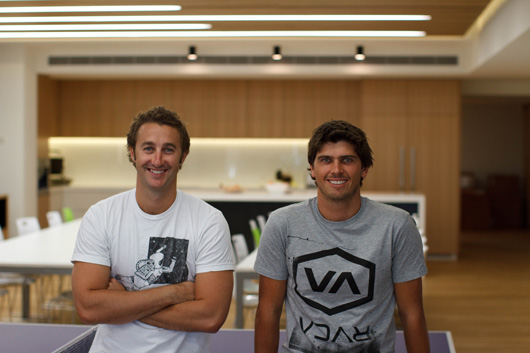
Dave (left) and co-founder Ben Richardson.
Did you ever consider taking on any investors? Why or why not?
Outside investment was never an option that interested us. I think there are a couple of reasons for this. First, we were building something for ourselves, so we already had a good idea what the problem was and how to solve it. Our background was designing and developing for the web, so we didn’t need to hire anyone. Plus, we could fund the whole process with the profits of our consulting business. We’re not talking big numbers here either. It’s amazing what a small team can achieve when you really focus for a couple of hours each day.
On top of this, the first version of Campaign Monitor was deliberately simple. We hosted it on a relatively cheap shared server with the rest of our clients. We spent next to nothing on marketing, and just relentlessly improved the product week after week.
How long did it take you to get the product to a point where it was profitable? How long until you stopped doing client work completely?
After launch we continued to spend an hour or two a day improving the product and talking to customers. By our sixth month Campaign Monitor revenues were already on par with our consulting business.
We’re quite conservative, and waited another six months before focusing on the product full-time. By this time Campaign Monitor was generating more than three times more revenue than the web design business, so we were comfortable making the transition. We didn’t want to leave our existing consulting clients in the lurch, so we created a new company to focus on Campaign Monitor and hired on a new team member to take over the web design business, which is still operating today.
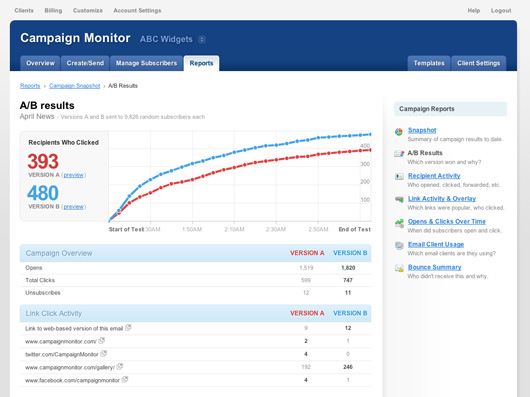
Screenshot of Campaign Monitor.
What is your culture/work environment like? How many hours a week do employees typically work?
Let’s start with the work environment. Making sure Campaign Monitor is a great place to work is one the biggest areas I focus on these days. And why shouldn’t it be? It’s where we spend the majority of our waking lives away from friends and family. Right now there are 22 people that give up their days to make Campaign Monitor as good as it can be. I have a very real obligation to help make this time as enjoyable as possible.
A few weeks back we moved into a new space we’ve spent the last 6 months fitting out. Every team member has their own closed office. We provide free breakfast and catered lunches for everyone. More importantly, the entire team eats lunch together every day. We have a huge common area with a couple of table tennis tables and games consoles. We also get out of the office regularly for social outings like surfing lessons, a winery tour or a game of lawn bowls (we’re going clay shooting this afternoon).
The culture side of things is difficult to define, and is really a product of the people we’ve hired over the last six years. We’re extremely picky on this front, and have turned down countless applicants with the right skills but the wrong attitude.
Typically each team member does a 40 hour week, but we’re flexible on when those hours need to happen. Our support team have a weekend roster, but the only time anyone else works on the weekend is if we’re doing a major release or fixing a critical bug. Of course, any time spent on the weekend is taken off the following week.
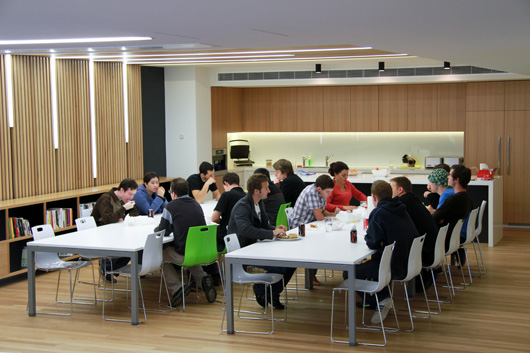
The team eating lunch together.
You’re moving into a new space with closed offices for every member of your team. Why are you choosing closed offices?
Over the last six years we’ve gone from open plan, to all closed offices and then to a combination of both. I’ve paid close attention to the pros and cons of each layout, and I’m convinced that closed offices are the best layout for a software company.
The reason for this is fairly simple. It’s all about removing distractions. Jobs like software development, design and copywriting often require juggling lots of different things in your head at once. Getting to this point doesn’t happen immediately either, it might take 15 minutes to really get your head around a problem. That’s when the good stuff starts flowing and can make all the difference.
While open plan might make communication easier, it makes distractions just as easy. The trade off isn’t worth it. Closed offices let you shut your door and get focused. Unless you’re sure your question is more important than what someone is working on (it rarely is), don’t interrupt them. Come back later or better yet, send an email instead. I think in many cases closed offices make communication better. Instead of interrupting someone to ask a question, you have to write it down. That takes more effort. It forces you to edit out the crappy stuff and focus on what’s important.
Closed offices doesn’t mean anti-social either. I can’t understate how valuable it is that we all eat lunch together every day and get out of the office regularly. It provides a nice balance to the closed offices, and it’s amazing how much more open and relaxing a conversation can be over a meal rather than a workstation.
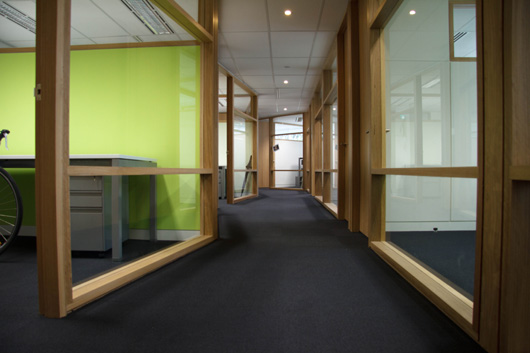
The corridor outside some closed offices.
You’ve said you focus on promotion through education. What’s been some of your biggest successes in doing that?
I think one of the best ways a company can build a relationship with their customers is to help them get better at something. When we launched Campaign Monitor six years ago, HTML email design really was a dark art. While browser limitations and workarounds were well known, there was next to nothing available on HTML emails. How do you make an email look good in Lotus Notes? Why isn’t this float working in Hotmail? You had to learn everything the hard way.
Over the years we’ve put together almost 350 articles and tips to help reduce this frustration for our customers. Some of our most popular resources include our regularly updated guide to CSS support in email, our free templates that work in all the major email clients and our email gallery showcasing beautiful email design. While each of these resources help current customers, they also consistently drive new customers our way on a daily basis. There’s also a certain feel good aspect to this type of promotion that you don’t get from banner ads or SEM, which is another reason we do a lot of it.
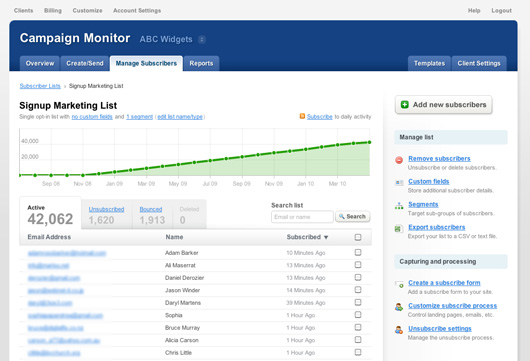
Screenshot of Campaign Monitor.
You’ve been big advocates for improving web standards support for HTML email. Why? How has taking a stand like this helped your business?
Support for web standards in email helps everyone. It makes our customers lives much easier by taking the pain out of building a HTML email. It makes email recipient’s lives easier because the email won’t be garbled by their email client or bloated with nested tables and inline CSS. If you’re interested, you can read more in my original call for standards support from a while back.
While there has traditionally been pressure on browser developers to embrace web standards support, email clients have gone in the opposite direction. After the release of Outlook 2007, which uses Word to render HTML emails, we decided it was time to take a stand for the better of the industry. Since that time we launched the Email Standards Project and worked with the likes of Yahoo!, Apple, Google and IBM to improve standards support in their email clients. After learning that Outlook 2010 would continue using Word to render emails, we launched fixoutlook.org which was hugely successful in bringing this issue to Microsoft’s attention.
It’s hard to say how well this has helped our business. No doubt it has bought additional customers to us, but more importantly it has strengthened our relationship with existing customers. They know we’re aware of how difficult their job can be at times, and that we’re working hard to try and solve some of these problems for them. It’s also been a lot of fun and very rewarding for our team.
You’ve focused on a niche industry (web designers). Why? Why not expand to reach more customers?
It’s much easier to build a great experience when you’re not trying to please everybody. Building a product that everyone likes is hard, and often the fastest route to mediocrity.
The needs of a web designer are very different to the needs of a travel agent or a coffee shop owner. By focusing just on designers, we can rip out a ton of irrelevant features our competitors offer and focus on the compelling stuff that’s perfect for that market. Lots of businesses turn to their web designer when they want to send an email newsletter, so this niche also offers a healthy reseller market. We sell to our customers, and they on sell to their clients at a marked-up rate.
And finally, we’re web designers ourselves. Building something that solves your own problem is much easier, and more enjoyable than building for an industry you’re not familiar with.
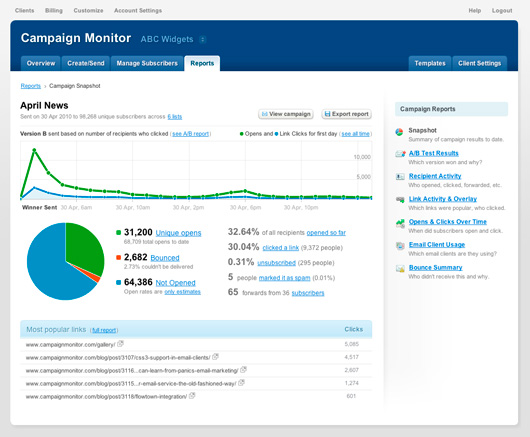
Screenshot of Campaign Monitor.
You had a nasty security breach late last year. What happened and how did you handle it? What did you learn from that experience?
There’s a bit of a story there. We had a security breach last August by a hacker looking to use our network to deliver large amounts of spam. Some customer accounts were compromised in the process. To make matters worse, my co-founder and I were on a surf trip in a remote chain of islands off Indonesia, eight hours from land with no communication with the outside world. Eventually we passed an island with a cell tower and got a barrage of SMS messages from our team asking us to call them.
By the time we got through, they’d already made the decision to go public with the news. They emailed all of our customers explaining what had happened, and what they were doing about it. The decision to be completely open about the incident was 100% the right call, but not an easy decision to make.
Because we were completely transparent, we had amazing support from our customers. Almost all of them got behind us with a positive message of some kind. I can’t tell you how proud I was of our team for how they handled it from start to finish. To top it off, we had our biggest sales month ever the very next month, which speaks volumes for respecting your customers and always being honest.
What’s your goal with the company?
Everything we do boils down to two things. Build the best email marketing software in the world for web designers and have fun doing it.
Any other advice for someone considering starting a business?
A few things come to mind:
- Don’t make excuses, start building something right now. Ideas are worthless unless they’re executed.
- Never be afraid to charge for your product from day one. If nobody is prepared to pay for it, it’s probably not solving an important problem anyway.
- Avoid additional investors if you can. There’s nothing more satisfying than being in complete control of your destiny.
- Never lose sight of the fact that you’re starting a business to give you more freedom to do what you enjoy in life. Don’t let it consume the very thing you’re aiming to improve.
Is your business profitable and proud? We’re looking for more companies that fit the bill ($1M+ in revs, no VC, profitable) to profile. Drop us a line with the subject “Profitable and proud” and let us know why your business would be a good match.

Josh Nichols
on 24 May 10Great interview. I wish there were more places like that to work for.
And thanks a ton for the Campaign Monitor resources section! I’ve used it so much to help me with HTML email designs. It is a black art.
Kyle Daigle
on 24 May 10This is a really excellent article and look forward to reading the rest of the series! Really great article.
VIkram
on 24 May 10Great Article,Thanks Matt!!
Gregor
on 24 May 10I already love the new series! I’m following Campaign Monitor since their early days and have always been impressed – by both their product as well as their philosophy.
I’m looking forward to get to know more companies that successfully followed the no VC way and I appreciate you give them a dedicated place in your blog!
Our company would fit in here as well, but we still have a long way to go until we reach the $1M+ in revenues – if we want to do that at all. As David Greiner points out, the financial success is not the only thing that defines success for us. Not taking VC gives us the freedom to say that.
Luis Pereira
on 24 May 10Awesome interview and series! Users need to wake up and realize that the freemium business model has a price to pay. Their thoughts, posts, pictures, videos, friends, and interests are all worth money to someone else.
Most startups and industry participants continue to fuel and support this false illusion by building and launching web services based on a freemium model that only works for Google and a few.
Jake McGraw
on 24 May 10Who came first, Basecamp or Campaign Monitor? Both apps have the same look and feel. Is this a case of cloning or mimicry?
John Freeborn
on 24 May 10I learned about Campaign Monitor years ago. while doing design research for email layouts. Over the years their emails and articles became an invaluable resource for me. I recently made the switch to Campaign Monitor and a large part of that (aside from the no-contract pricing model) was the commitment and openness to helping designers work in this field.
Jesse
on 24 May 10Great post!
looking forward to the rest in this series
John
on 24 May 10I think you should add a fourth qualifier for your series: companies that aren’t located in Silicon Valley/San Francisco Bay Area
todd g
on 24 May 10Thanks for sharing this info David! It’s great to hear about companies like this.
Rafael Spínola
on 24 May 10They got to the point with: “While open plan might make communication easier, it makes distractions just as easy. The trade off isn’t worth it. Closed offices let you shut your door and get focused. Unless you’re sure your question is more important than what someone is working on (it rarely is), don’t interrupt them. Come back later or better yet, send an email instead. I think in many cases closed offices make communication better. Instead of interrupting someone to ask a question, you have to write it down. That takes more effort. It forces you to edit out the crappy stuff and focus on what’s important.” I suffer a lot of interruptions on an open 800m² office and I just can’t focus on anything at all.
Tim Jahn
on 24 May 10Great article and I’m really looking forward to this series.
I think John above has a point regarding seeking companies outside the “valley”. While I don’t believe location is necessarily important (or relevant) always to succeeding, I do think the “valley” gets a majority of the attention and encouragement in the tech space, which your series will be about.
Definitely focus on seeking out the best companies out there that fit the series criteria. But, considering your team is comprised of talent from all over the world in a variety of cities/countries, it would be nice to see some tech companies that are doing awesome things in other places too.
Can’t wait for the next interview! :)
Lukes Beard
on 24 May 10Really enjoyed this. Great seeing how one of my favourite company works.
Always respected how Campaign Monitor do their thing and now I do even more.
Vinicius Manhaes Teles
on 24 May 10What a wonderful article! Congratulations for the new series “Profitable and proud”. This was a very good idea!
I’m looking forward to read the next posts in this series.
Mohit
on 24 May 10I am sorry, but does not 37s preaches profit over revenue? Why keep criteria to be $1M+ revenue, than say $200,000 annual profit?
Great interview btw. Especially like the piece about close door offices for employees, and how your employees handled critical situtation, without instructions (or explicit permission). Goes to show mutual trust between company and employees.
DRoss
on 24 May 10Great article/interview.
Been a fan of Campaign Monitor for 5-6 years now and it’s been fun watching them grow and get great at doing what they do. They pay attention to the tiny details and are always friendly. This is why they are the best in the business.
Noam
on 24 May 10This is a great idea for a new series of posts! Of the companies that fit within the “profitable and proud” frame ($1M+ in revs, no VC, profitable) it will be interesting to see how many base their philosophy on “the 37s way” and how many have a different approach to doing business (while still not taking on VC and being profitable).
This interview with Campaign Monitor was definitely very interesting but it would be great to learn about successful businesses that significantly differ from 37s philosophy.
Thanks!
Hashim Warren
on 24 May 10Love this idea for a series. I wish I’d known about Campaign Monitor before I chose MailChimp.
Question: Would 37Signals be eligible forthis series considering the investment from Bezos?
Giles Bowkett
on 24 May 10Please make Profitable & Proud a regular, ongoing feature!
Giles Bowkett
on 24 May 10Please add a delete comment link for when I get too excited to read the first line of the post!
praka
on 24 May 10We are a tax company using them for years now, as a minimal crm also.
Cory Perry
on 24 May 10Awesome interview, looking forward to more from the new series!
I love reading about tech companies that bypass the VC and make it work from the ground up. Very inspiring to say the least!
Joris Witteman
on 24 May 10Thanks 37signals for this interview, please keep them coming.
Also, I have to second the Thank You to Campaign Monitor for their HTML email client compatibility resources. They are invaluable.
Ben Atkin
on 24 May 10This is one of my all-time favorite Signal vs. Noise articles. I’m really looking forward to the next one in the series. Keep it up!
I think we’ll see that profitable companies have a lot more in common with 37signals than just profitability. Campaign Monitor takes weekends off, doesn’t work long hours, has an office in a nice city to live in, uses computers for intra-office communication rather than interrupting every time, etc.
Ivan Cherevko
on 24 May 10The focus on “web designers” seems kinda silly to me. I mean, Campaign Monitor is a well-known email service; I wonder, how many of its clients are actually design shops?
Jimmy Chan
on 24 May 10They’re really sounds like 37signals.
Or because 37signals is their client?
Bjarni Wark
on 25 May 10Yeah for Dave, Ben and Campaign Monitor.
Thanks for sharing your story, inspiring.
By the sounds of it you have a very special team working for/with CM.
If you ever need someone to join the team and go on those surfing safaris can you put me on that list : )
Tim
on 25 May 10Oooh, I wish they were in MelBurn, not Sydeneeeee.
Good article.
Michael Troy
on 25 May 10What I love about Campaign Monitor the most, is not the fact that they are industry leaders, but that they are real trailblazers in the Australian software industry and online community.
Campaign Monitor is teh punk.
Jon Livingston
on 25 May 10Appreciate the interview and insight into Campaign Monitor. Using them from early on I’m continually impressed with their tools, attention to detail and service. The app actually makes HTML emails fun. If you haven’t tried them out I would definitely take a look.
Great to hear Dave talk about how they define success. I wish more companies could understand that. From support communication to his writings you see that he enjoys what he does. Thanks for sharing.
Ugur Gundogmus
on 25 May 10Very good interview.
I have been using Campaign Monitor for my clients for the last 2 years. I think they got bigger and bigger, but the quality of their service didn’t show the same trend. I believe they should focus on the the basics instead of adding new features since some of these new features have lots of bugs.
Argo Wibowo
on 25 May 10This is a wonderful interview. It’s been a long time since I read interesting post on entrepreneur on SVN. Like 37Signals, this is a good role model for worldwide business. Thanks Again. :)
GM
on 25 May 10Can I just saw that both Dave and Ben are extremely easy on the eyes? Thanks for the inspiring story and the eye candy SVN!
Nick Lindwall
on 25 May 10great, great post. A really interesting interview and I love campaign monitor, we started using it lasted year and has gone down a storm with our clients.
Blaine
on 25 May 10Having CM’s new place include closed offices is really interesting, and I totally agree with your statement! It’s interesting to me there wasn’t more detail on your workspace, and the photos don’t reveal much. Where are your whiteboards, dual-monitors, etc.?
Jon Moss
on 25 May 10Great article and very interesting to hear about the Campaign Monitor story / evolution.
It got me thinking that out of all the businesses I’ve worked for, with, visited here in the UK, there has only been one with a real focus on making the environment nice for their employees.
It is not rocket science, but so many businesses do not make any effort in this area – almost the opposite.
Paul Montwill
on 25 May 10They are so lucky to have such great employees.
Greg
on 25 May 10Wow, a company that follows all of 37 Signals’ advice and seems to be successful (according to 37 Signals definition of success) and is being featured by, of all people, 37 Signals !!! What a coincidence.
Why don’t you look for huge companies that somehow have happy employees, or small companies that do well despite ignoring 37 Signals’ principles? Maybe you’d learn something, instead of just engaging in cheap self-promotion.
Scott
on 25 May 10Thanks for sharing this inspirational and informative story. Looking forward to more in the series.
JF
on 25 May 10Greg: A little trigger happy this morning? This is the first article in the series. Give us a chance, eh?
We don’t care if they follow 37signals principles or not – that’s not the point. The point is that they didn’t take investment and they’re profitable and proud of it.
These articles aren’t specifically about making employees happy – plenty of companies that are losing plenty of money can make their employees happy by shielding them from the bad news, catering their meals, paying them way above market salaries, etc. Making people happy is great, but if it’s not sustainable (profitable) then it’s all just temporary happiness. Temporary happiness isn’t the happiness we’re after.
So if you know of a big (or small) company that was bootstrapped, is profitable, and a great place to work, please do send over your suggestions. We’ll be happy to follow-up.
Alexandre Ribeiro
on 25 May 10What i love in this type of companies is the simplicity behind them, they always start simple and grow honest. The purpose, the backbones, the philosophy, the needs for hiring the right people, the principles, all those things turn the product “big” before it becomes big in reality. Investing in the product without being driven by money it´s huge, instead they are driven by purpose and fun. It´s like investing in a young child, putting everything they believe in it and then, when the product grows, it grows brilliant and the money seems to fallout of the trees without big effort to catch it, all the big effort was made way back. It´s so nature like.
Love that, Thanks Matt.
Michael Hoitomt
on 25 May 10Excellent Post! It is inspirational to read about how others have created successful business. I’m really looking forward to future posts. Thanks!
HowToPlaza
on 25 May 10A very well conducted interview. Basically, it sums up to what suits you as an organization and as individuals working with that organization. I love the way 37 Signals does business.
~ Sarah ~
Hibiscus
on 25 May 10Great article. I’ve been a fan of Campaign Monitor for many years. As a web agency account person, I once had to advise a client on email template design and got up to speed quickly by spending about five hours looking at the examples in their Gallery and their comments. I then parlayed that knowledge into a role as “Email Marketing Expert” at my next company, so thank you!
I too look forward to the next installments in the series.
steve
on 25 May 10Very good article… 37 signals and Campaign Monitor started as a web design for customer project based company and end with selling a freemium web app based. Can I make the conclusion that to begin a startup, we have need a customer project first, who is willing to pay for that what we are building? And we have to have experience with good (web) design to fulfill customer usability needs.
Robert J. McCarter
on 26 May 10This is good stuff, thanks for starting the series, I look forward to more.
Markus
on 27 May 10These guys are great proof that many points of “getting real” and “rework” are actually valid. Interviews like this are convincing me even more to go a similar path.
Glenn Edley
on 29 May 10I really enjoyed this article. Really helped me with a business decision I have to make. Big fan of Campaign Monitor so great to get a good insight into how they got to where they are today. Thanks for being so open too Dave.
Jo Potts
on 29 May 10Fantastically inspirational article and company.
Bootstrapping is way harder than I’d ever imagined – a real roller coaster ride. Definitely worth every second though, especially as the hard work starts to pay off. Dave and Ben’s company goals – build the best product and have fun – are a huge key to success but don’t forget the rest! Looking forward to the next article. Thanks.
This discussion is closed.